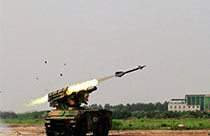

BEIJING, Sept. 6 -- Tibet's GDP soared from 327 million yuan in 1965 to 92.08 billion yuan (14.5 bln U.S. dollars) in 2014, a 281-fold increase, a government white paper published Sunday said.
It showed that under the system of regional ethnic autonomy, Tibet's economic and social development has achieved leapfrog development by constantly reaching higher levels, according to the white paper titled "Successful Practice of Regional Ethnic Autonomy in Tibet."
Since 1994, the local GDP has grown at an annual rate of 12.4 percent on average, registering double-digit growth for 20 consecutive years. Local fiscal revenues increased from 22.39 million yuan in 1965 to 16.475 billion yuan in 2014, an average annual increase of 14.46 percent, further enhancing Tibet's self-development capabilities, the paper said.
People in both urban and rural areas are living a richer and fuller life as their incomes increase rapidly. In 2014 the per capita disposable income of urban residents reached 22,016 yuan, a 38-fold increase, or an average annual increase of 10.7 percent compared with 565 yuan in 1978; and that of farmers and herdsmen was 7,359 yuan, representing an average annual increase of 10.9 percent, according to the paper.
Both urban and rural residents' living conditions have greatly improved. Tibet took the lead in 2006 in initiating low-income housing projects for local farmers and herdsmen. By the end of 2013, the Region had appropriated 27.8 billion yuan and finished building 460,300 low-income houses, said the paper.
 'Enemy planes' intercepted by Hongqi-7B air-defense missiles
'Enemy planes' intercepted by Hongqi-7B air-defense missiles Blind date with bikini girls in Nanjing
Blind date with bikini girls in Nanjing Amazing photos of Chinese fighter jets
Amazing photos of Chinese fighter jets Chinese soldiers participate in training for V-Day parade
Chinese soldiers participate in training for V-Day parade Painting: Lonely women in Forbidden City
Painting: Lonely women in Forbidden City China and Russia hold joint drill in Sea of Japan
China and Russia hold joint drill in Sea of Japan 'Goddess' in Taiwan McDonald's
'Goddess' in Taiwan McDonald's Female soldiers at military parades
Female soldiers at military parades Photos of campus belle doing splits go viral
Photos of campus belle doing splits go viral Best blade forward
Best blade forward Infographic: Parsing China's massive V-day parade
Infographic: Parsing China's massive V-day parade Giant panda cub receives medical care in Guangzhou
Giant panda cub receives medical care in Guangzhou China celebrates 70th Anniversary of Victory of World Anti-Fascist War
China celebrates 70th Anniversary of Victory of World Anti-Fascist WarDay|Week